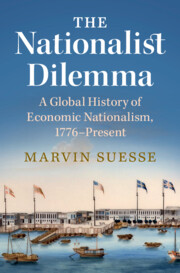Book contents
- The Nationalist Dilemma
- The Nationalist Dilemma
- Copyright page
- Dedication
- Contents
- 1 Introduction: Nationalists Think About the Economy
- 2 The American Community of the Common Man, 1776–1860
- 3 The Birth of the National Economy in Europe, 1789–1860
- 4 The Globalisation of the Nation, 1861–1913
- 5 The Nationalist as Saviour, 1914–1945
- 6 Policy in a World of Nation-States, 1946–1978
- 7 The Incomplete Building of a Global Economy, 1979–2001
- 8 Populist Discontents, 2002–2021
- 9 Conclusion and Outlook: Explaining Economic Nationalism
- Notes
- Index
6 - Policy in a World of Nation-States, 1946–1978
Published online by Cambridge University Press: 25 April 2023
- The Nationalist Dilemma
- The Nationalist Dilemma
- Copyright page
- Dedication
- Contents
- 1 Introduction: Nationalists Think About the Economy
- 2 The American Community of the Common Man, 1776–1860
- 3 The Birth of the National Economy in Europe, 1789–1860
- 4 The Globalisation of the Nation, 1861–1913
- 5 The Nationalist as Saviour, 1914–1945
- 6 Policy in a World of Nation-States, 1946–1978
- 7 The Incomplete Building of a Global Economy, 1979–2001
- 8 Populist Discontents, 2002–2021
- 9 Conclusion and Outlook: Explaining Economic Nationalism
- Notes
- Index
Summary
As empires fragmented after the second world war, politicians in the Global South finally had the opportunity to determine the economic policies of their newly independent states. As many of these countries were relatively poor, developmental ideas came to the fore once more. This is true both in sub-Saharan Africa as well as in Asia. Nationalist movements in these regions combined their nationalist economic ideas with a variety of complementary ideologies. In sub-Saharan Africa, politicians such as Kwame Nkrumah and Julius Nyerere turned to socialism, which they interpreted as a developmental system. In Japan, South Korea and Taiwan, governments espoused free market economics, which they supplemented with an activist state that promoted exports. Argentina and Egypt, on the other hand, saw the rise of populist regimes. These provide another important type of economic nationalism. Populists such as Juan Perón and Gamal Abdel Nasser associated international integration with enrichment by domestic elites Because they opposed these elites, populists sought to cut links with the world economy and espouse isolationist economic systems.
Keywords
- Type
- Chapter
- Information
- The Nationalist DilemmaA Global History of Economic Nationalism, 1776–Present, pp. 180 - 222Publisher: Cambridge University PressPrint publication year: 2023



